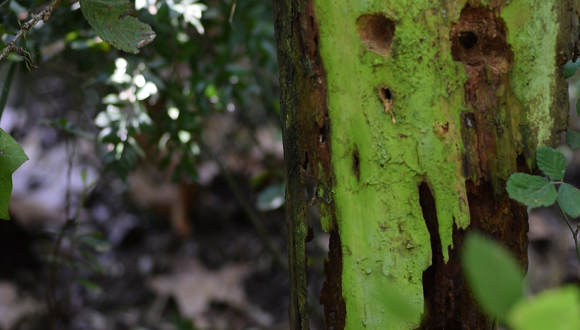Anoia and Bages suffered a large forest fire in July 2015, which burned 1,235 ha. Areas of Aleppo pine that had been thinned previously are recovering better than non-thinned areas in terms of resprouting species of trees and shrubs. The regeneration of the Aleppo itself has been more modest and sparse, but they can be found throughout the burnt area.

Sparks are thrown into a pile of hay; it quickly burns. High temperatures and low humidity favor the expansion of the fire. The date is July 26th 2015, the day which incorrect use of a hay chopper became ground zero for the Òdena forest fire. More than one thousand hectares were impacted in the Catalonian counties of l’Anoia and Bages, which were high fire risk zones in 2015 due to the heat wave and drought in that year.
Much of the burnt forest was dominated by Aleppo pine (Pinus halepensis), and this area had in fact unfortunately already suffered a fire in 1986. The area was undergoing recovery and most of the pines were young. For the past year a CREAF team has been studying the affected young pines, trees which had been managed by the Entorns de Monstserrat Landowners Association with support of the Barcelona Regional Government. “We have seen that forest management is key. In the groves of young pines where previously the density was greater and had been reduced, the effects of the forest fire were nearly 50% less severe,” says CREAF researcher Josep Maria Espelta. He adds, “this has favored higher resprouting of shrub and tree species in these areas and will aid the recovery of the burnt area.”

Resprouting shrubs and trees are the first to return in the burnt area
Parts of areas which had been thinned are already green with the resprouting species; such species have banks of underground buds, protected from the fire, which will grow into new shoots. With this strategy the plants can regenerate quickly and the researchers already found holm oak (Quercus ilex), kermes oak (Quercus coccifera), strawberry tree (Arbutus unedo), and heather (Erica sp.) six months after the fire. At one year, resprouted plants cover up to 40% of the burnt surface in the thinned areas.

In the case of the Aleppo pines that burned – these not capable of resprouting, but which must instead rely on germination – their regeneration has been “modest and variable throughout the area, maybe due to the fact that the drought last autumn and winter was very intense,” says Dr. Espelta. He adds, hopefully, that “at least we are finding it everywhere, both in managed and non-managed areas, and in some areas it is actually quite dense.” This is good news, since it will aid the successful regeneration of the forest.
The condition of burnt trees indicates the severity of the fire
During the fire, many pines died from the high temperatures or burning, though some retained their trunks and branches; examining these remaining parts helps the researchers understand the severity of the fire.

In the case of the Òdena fire, almost 75% of the burnt trees analyzed were moderately affected (severity level 1), and while they lost all their leaves they still had secondary branches and pine cones. Although a tree may die, a large amount of its pine nuts can be protected by the cone and spill out when it opens. “This is a good strategy for germination in areas with little competition,” says Josep Maria Espelta, “but this is a complex system for regeneration and it will be some time before we know if the new pines are able to become successfully established.”
Once again, the results show the necessity of forest management. Forest thinning in stands of young Aleppo pines not only helps regeneration after fire or other disturbances, but it also promotes good forest structure and dynamics. And why are these characteristics desirable? It is important to keep in mind all of the goods and services provided by such ecosystems, including wood or CO2 sequestration, critical in the current context of climate change.







